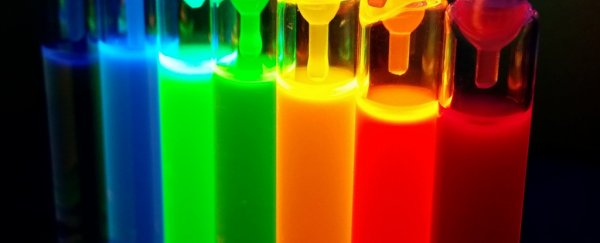Solid, crystalline structures of incredibly tiny particles known as quantum dots have been developed by engineers in the US, and they're so close to perfect, they could be a serious contender for a silicon alternative in the super-fast computers of the future.
Just as single-crystal silicon wafers revolutionised computing technology more than 60 years ago (your phone, laptop, PC, and iPad wouldn't exist without one), quantum dot solids could change everything about how we transmit and process information in the decades to come.
But despite the incredible potential of quantum dot crystals in computing technology, researchers have been struggling for years to organise each individual dot into a perfectly structured solid - something that's crucial if you want to install it in a processor and run an electric charge through it.
The problem? Past efforts to build something out of quantum dots - which are made up of a mere 5,000 atoms each - have failed, because researchers couldn't figure out how to 'glue' them together without using another type of material that messes with their performance.
"Previously, they were just thrown together, and you hoped for the best," lead researcher Tobias Hanrath from Cornell University told The Christian Science Monitor. "It was like throwing a couple thousand batteries into a bathtub and hoping you get charge flowing from one end to the other."
(Don't try that at home…)
Instead of pursuing different chemicals and materials that could work as the 'glue' but hinder the quantum dot's electrical properties, Hanrath and his team have figured out how to ditch the glue and stick the quantum dots to each other, Lego-style.
"If you take several quantum dots, all perfectly the same size, and you throw them together, they'll automatically align into a bigger crystal," Hanrath says.
To achieve this, the researchers first made nanocrystals from lead and selenium, and built these into crystalline fragments. These fragments were then used to form two-dimensional, square-shaped 'superstructures' - tiny building blocks that attach to each other without the help of other atoms.
Publishing the results in Nature Materials, the team claims that the electrical properties of these superstructures are potentially superior to all other existing semiconductor nanocrystals, and they could be used in new types of devices for super-efficient energy absorption and light emission.
The structures aren't entirely perfect though, which is a key limitation of using quantum dots as your building blocks. While every silicon atom is exactly the same size, each quantum dot can vary by about 5 percent, and even when we're talking about something that's a few thousand atoms small, that 5 percent size variability is all it takes to prevent perfection.
Hanrath says that's a good and a bad thing - good because they managed to hit the limits of what can be done with quantum dot solids, but bad, because they've hit the limits of what can be done with quantum dot solids.
"It's the equivalent of saying, 'Now we've made a really large single-crystal wafer of silicon, and you can do good things with it,'" he says in a press release. "That's the good part, but the potentially bad part of it is, we now have a better understanding that if you wanted to improve on our results, those challenges are going to be really, really difficult."
"I see this paper as sort of a challenge for other researchers to take this to another level," one of the team, Kevin Whitham, adds. "This is as far as we know how to push it now, but if someone were to come up with some technology, some chemistry, to provide another leap forward, this is sort of challenging other people to say, 'How can we do this better?'"
That's a "Game on, fellow engineers," if ever I heard one. Go forth and conquer!
